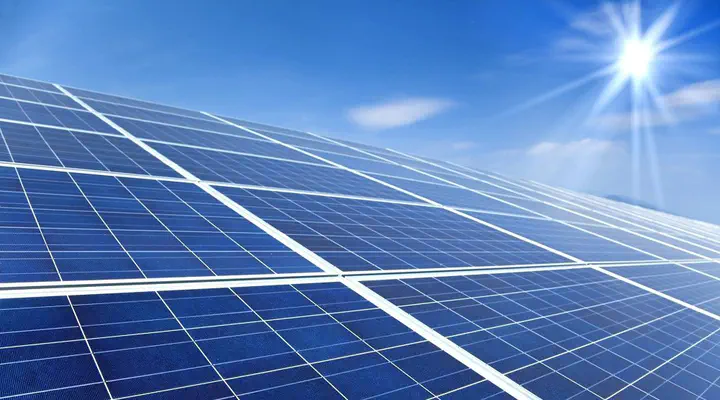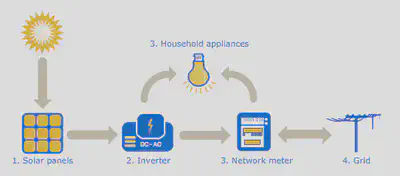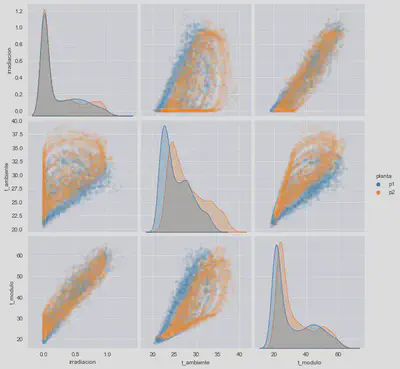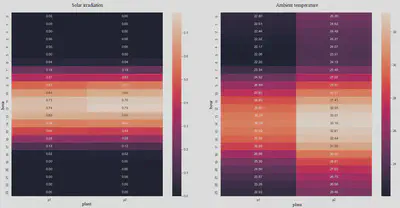Inefficiency Detection in Photovoltaic Solar Plants

Note: Current documentation available on the GitHub repository is in Spanish. It will soon be updated to English.
Table of contents
Introduction
The client is a renewable energy generation company that has detected anomalous behaviors in two of its photovoltaic solar plants. Their maintenance subcontractor is unable to identify the reasons for the inefficiencies and they wish to perform an in-depth analysis of the plants’ sensor and meter data before mobilizing their engineering team.
Notes:
- This article presents a technical explanation of the development process followed in the project.
- Source code can be found here.
Objectives
Analyse the available data to try to figure out where the problems may be and whether or not it is necessary to send a engineering team to the plants.
Project design
Understanding the operation of a photovoltaic solar plant
In order to identify the business levers on which to focus the analysis, it is necessary to understand the basic operation of a photovoltaic solar plant.
Photovoltaic solar plants directly convert solar energy into electricity. They work on the principle of the photovoltaic effect. When certain materials are exposed to light, they absorb photons and release free electrons. This phenomenon is called as the photoelectric effect, wich is a method of producing direct current electricity based on the principle of the photoelectric effect.

Based on the principle of photovoltaic effect, solar cells or photovoltaic cells are made. They convert sunlight into direct current (DC) electricity. But, a single photovoltaic cell does not produce enough amount of electricity. Therefore, a number of photovoltaic cells are mounted on a supporting frame and are electrically connected to each other to form a photovoltaic module or solar panel. According to the requirement of power, multiple photovoltaic modules are electrically connected together to form a PV array and to achieve more power.
The generated DC electricity is then converted to alternating current (AC) which is cheaper and easier to transport and is the type of electrical current used when you plug appliances into normal wall sockets. This transformation process is accomplished by means of a device called inverter.
On the other hand, within the plant ecosystem there are also power meters (for measuring both DC and AC current) and sensors of different types (temperature, irradiation, …).
Finally, the AC current is transported to the different consumers through the distribution network.
Levers
Once the fundamentals of the operation of a PV solar plant have been analised, the levers that influence the business objective (in this case generating AC) have been identified:
Solar irradiation: the higher the irradiation, the higher the DC generated. However, it is not monotonic; above certain values, higher temperatures decrease the generation capacity.Panels conditions: panels have to be clean and in proper working conditions in order to generate as much DC as possible.Inverters efficiency: there is always a loss in the transformation from DC to AC, but it should be the minimum possible. Inverters have also to be in good conditions.Meters and sensors: if they break down and/or do not measure properly, traceability and the possibility of detecting faults is lost.
KPIs
Solar irradiation: measures incoming solar energy.Ambient and panel temperature: measured by the plant’s sensors in degrees Celsius.DC power: measures the generated kW of direct current.AC power: measures the generated kW of alternating current.Inverter efficiency: measures the transformation capacity from DC to AC. It is calculated as $\dfrac{AC}{DC} \cdot 100$.
Entities and data
To determine the entities it is necessary to know what a solar plant is composed of:
- The minimum unit is the cell, where the generation of energy by reaction with the sun’s photons takes place.
- Cells are encapsulated in ‘rectangles’ called modules.
- Several modules form a panel.
- Panels are arranged in rows called arrays.
- An inverter receives direct current from several arrays.
- A plant can have several inverters.
- There are also meters and sensors.
In the present project the existing entities in the granularity of the data provided by the company are:
- Data in 15-minute windows over a period of 34 days.
- Solar photovoltaic plants: two of them.
- Inverters: several per plant.
- A single irradiance sensor per plant.
- A single ambient temperature sensor per plant.
- A single module temperature sensor per plant.
This information will condition the analyses that can be carried out. For example, it will be possible to determine if an inverter in a plant is underperforming, but it will not be possible to determine which array, panel or module may be causing these inefficiencies.
Data quality
In this stage of the project, general data quality correction processes have been applied, such as:
- Feature renaming
- Feature type correction
- Elimination of features with unique values
- Nulls imputation
- Outliers management
- …
The entire process can be consulted in detail here.
Exploratory data analysis
The aim of this stage of the project is to discover trends, patterns, and to check assumptions with the help of statistical summary and graphical representations. Complete analysis can be found here.
Once the business levers, kpis and entities have been established, a number of seed questions are posed to serve as a basis for developing and deepening the analysis of the different features.
Seed questions
Regarding solar irradiation:
Q1: Is there enough solar irradiation every day?Q2: Does a similar amount of solar irradiation reach both plants?Q3: What is the hourly distribution of solar irradiation like?Q4: How is the received solar irradiation related to the ambient temperature and the module temperature?
Regarding photovoltaic solar plants:
Q5: Do they receive the same amount of irradiation?Q6: Do they have a similar number of inverters?Q7: Do they generate similar amount of DC?Q8: Do they generate similar amount of AC?
Regarding DC generation:
Q9: What is the relationship between solar irradiation and DC generation?Q10: Is DC generation affected at any time by ambient or module temperature?Q11: Is it similar in both plants?Q12: How is it distributed throughout the day?Q13: Is it constant throughout the days?Q14: Is it constant across all inverters?Q15: Have there been times of failure?
Regarding AC generation:
Q16: What is the relationship between DC and AC generation?Q17: Is it similar in both plants?Q18: How is it distributed throughout the day?Q19: Is it constant throughout the days?Q20: Is it constant across all inverters?Q21: Have there been times of failure?
Regarding meters and sensors:
Q22: Are solar irradiation data reliable?Q23: Are temperature data reliable?Q24: Are DC generation data reliable?Q25: Are AC generation data reliable?Q26: Are the data between the two plants similar?
Example of some of the analyses that have been conducted:



Results
Insights
After a detailed analysis of the data from the photovoltaic solar plants it can be concluded that:
-
There are serious data quality problems. The part of the chain where these problems are generated, including the plant meters, should be reviewed.
-
The fact that the DC generation is about 10 times higher in plant 1 than in plant 2, added to the fact that the efficiency in plant 1 is above 10% leads to think that the DC generation data in plant 1 may be artificially scaled for some reason.
In the absence of further necessary checks, and assuming that the data are correct:
- Both plants have received high amounts of irradiation, no problems have been located at this stage.
- Although the ambient temperature is higher in Plant 2 and its modules are warmer than those of Plant 1, this does not seem to have a significant impact.
- Plant 1’s DC generation works properly, the modules seem to bring DC to the inverters.
- Plant 2’s DC generation does not work properly, some modules deliver very limited DC to the inverters even during peak irradiance hours.
- DC to AC conversion of Plant 1 does not work well, it only transforms around 10% consistently. And this low efficiency is not due to moments of non-reception of DC nor is it concentrated in specific inverters, but it seems to be more structural (note that it could be due to data quality problems in the data regarding DC generation of Plant 1).
- DC to AC conversion of plant 2 works properly, reaching efficiency levels up to 97%.
Recommended actions
- Review data collection processes and their reliability.
- Perform a maintenance inspection on the identified inverters of Plant 2 in which there are many moments of zero DC generation.
- Perform a maintenance inspection of all inverters of the Plant 1.